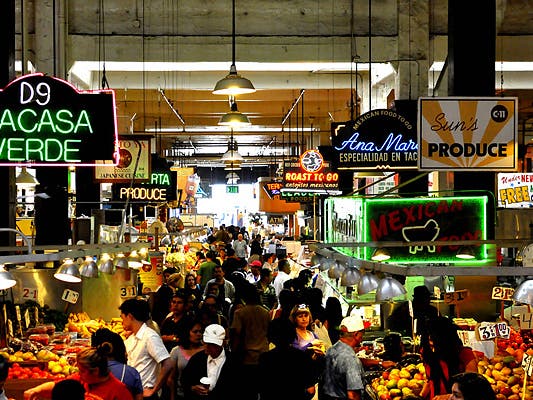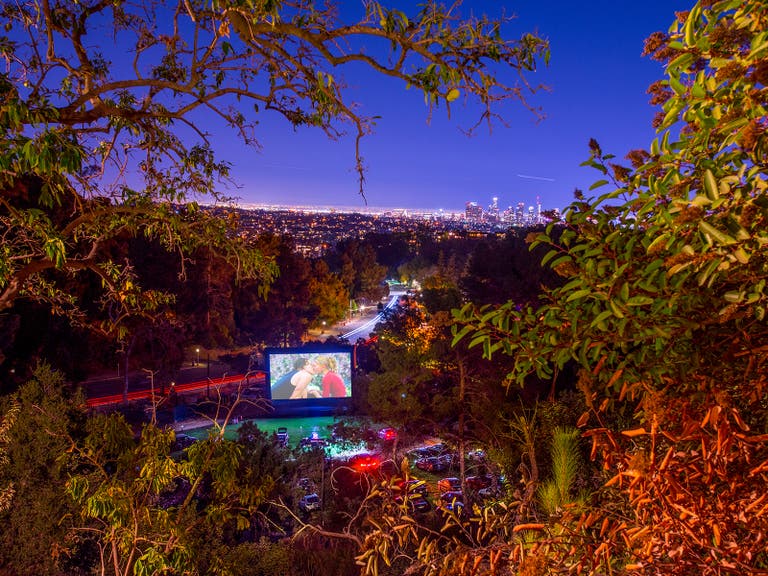10 Things You Probably Didn’t Know About Los Angeles

“When the legend becomes fact, print the legend,” goes the famous quote from John Ford’s 1962 classic Western flick The Man Who Shot Liberty Valance. Few quotes ring truer when it comes to an understanding of Los Angeles, whose growth was largely built upon its ability to create works of fiction seen by millions worldwide. Publicity notwithstanding, though, there are many little-known facts about LA that often get lost amid the hoopla. Here are 10:
1. Water-View Ballpark?
If all of the woven straw hats worn by Silver Lake hipsters have you down, imagine what the area would be like with a few thousand people wearing lids with the interlocking “L” and “A” about 80 times a year. That’s right, Silver Lake was once proposed as a possible site for Dodger Stadium (1000 Elysian Park Ave., Los Angeles, 323.224.1500). The Garbutt-Hathaway Estate, located on the hill just southeast of the reservoir, was one of four possible locations a 1956 city report pitched as possible sites for a future home field for the then-Brooklyn Dodgers (the LA Coliseum, the old Wrigley Field in South Los Angeles and Chavez Ravine were the others). Alas, the Dodgers moved to the Coliseum in 1958, with their more permanent home built in Chavez Ravine four years later.
2. Mystical Muse
What do the Beatles “Blue Jay Way,” Crosby Stills & Nash’s “Our House,” and the Doors’ “Love Street” all have in common? All were written about locations in the Hollywood Hills. The George Harrison gem references one of the so-called “bird streets” (Warbler Way, Oriole Drive, Skylark Lane, Mockingbird Place, etc.) that wind their way through the hills above West Hollywood. Graham Nash wrote “Our House” about the Laurel Canyon abode he shared at the time with then girlfriend Joni Mitchell, while the Jim Morrison-penned “Love Street” referenced the Laurel Canyon hippie scene of the late 1960s. Fortunately, spring and summer provide an opportunity to experience two of the country’s best outdoor music venues right nearby: The Hollywood Bowl (Hollywood Bowl, 2301 N. Highland Ave., Los Angeles, 323.850.2000) and the Greek Theatre (2700 N. Vermont Ave., Los Angeles, 323.665.5857).
3. San Pedro Spa Treatment
Housing one of the largest U.S. commercial ports, San Pedro isn’t exactly synonymous with spa treatments, but that’s what folks could get during the early part of the last century. Between 1917 and the late 1930s, White Point Hot Spring Hotel was located at the current site of Royal Palms County Beach. The resort included a hotel, restaurant, boating area and salt-water pools, as well as access to a sulfur hot spring, and was especially popular with Japanese-Americans. By the late ‘30s, though, an earthquake that cut off access to the hot spring and the Great Depression hastened the resort’s demise. Today, people can visit San Pedro’s Cabrillo Marine Aquarium (3720 Stephen M. White Dr., San Pedro, 310.548.7562) to watch the grunion spawn. Open season is in March, June and July, when people can hold the silvery fish over the nighttime sand.
4. ‘Long’ Story Short
Speaking of ports, if you go back about a century, “Port Los Angeles” (no “of”) meant the Santa Monica Bay, not San Pedro or Long Beach. Starting in the 1890s, Southern Pacific railroad magnate Collis Huntington, whose tracks ran between Downtown and Santa Monica and up the coast, started funneling money towards making Santa Monica Bay the primary shipping harbor for the region, and in 1893 built the Long Wharf just north of Santa Monica Canyon. The world’s longest wooden pier measured more than 4,700 feet, or almost three times the length of Santa Monica Pier. Four years after being built, however, the city deemed San Pedro its official harbor, and the Long Wharf was dismantled by 1921. Today, Will Rogers State Beach (17700 Pacific Coast Highway, Pacific Palisades, 310.305.9503) offers almost two miles of sand, volleyball courts, bike paths and surf where the Long Wharf once jutted out almost a mile into the ocean.
5. Royal Blues
An LA native by way of South America and San Diego? So go the travels of the jacaranda tree, those bright blue-purple-sprouting trees synonymous with Los Angeles that wow visitors but annoy garden keepers with their sticky leave-droppings. While often associated with spring in LA, jacaranda seeds were actually first brought to the U.S. from South America by turn-of-the-20th-century horticulturist Kate Sessions, who planted the trees, along with about a half-dozen other tree species, all over San Diego’s Balboa Park. Curious about more flora? Descanso Gardens (1418 Descanso Dr., La Canada-Flintridge, 818.949.4200), in La Canada-Flintridge, is a 160-acre urban oasis complete with a camellia oak forest, streams, a lake, bird sanctuary, five-acre International Rosarium and tons of colorful flower displays, not to mention a mini-train route for the kids.
6. Extended Play
Warner Bros.’ The Jazz Singer, credited for being the first film with synchronized sound and the first “talkie” (both claims have been disputed), may have been about a Rabbi’s son trying to make it big on Broadway, but the 1927 release is a quintessentially Los Angeles movie, from its filming locations at Iverson Ranch in Chatsworth to its world premier at Downtown’s Tower Theater. Heck, even star Al Jolson made sure his fans kept it a local affair by being buried at Hillside Memorial Park near Culver City.
7. Posh Ride
No one would question the insanely high value of real estate that runs along the south side of Wilshire Boulevard in Beverly Hills, whose stretch includes the Beverly Wilshire, a Four Seasons Hotel (9500 Wilshire Blvd., Beverly Hills, 800.427.4354), mixed in with lots of posh shops and offices. Which makes it hard to fathom that the first thing built along that stretch was a race car track. The Beverly Hills Speedway was a one-mile oval wooden-board track that held 250-mile auto races starting in 1920, though was dismantled four years later once the local business community discovered the wonders of triple-net rent. That said, about three miles east, race car junkies will be easily sated at the Petersen Automotive Museum (6060 Wilshire Blvd., Los Angeles, 323.930.CARS), which has more than 150 rare and classic cars, trucks, motorcycles and other things on wheels, and covers four floors and more than 300,000 square feet of space.
8. Golden Voice
Local baseball fans often associate Gene Autry with the Angels, as the “Singing Cowboy” owned the team from its 1961 inaugural season until a year before his death in 1998, but Autry didn’t initially intend to own a baseball team. The entertainer was actually bidding for radio-broadcasting rights for the expansion team that was awarded to Los Angeles in the late 1950s. He was talked into owning the team, which played in South Los Angeles’ Wrigley Field in 1961 and Dodger Stadium from 1962 to 1965, before moving to Orange County. Autry’s legacy lives on at Griffith Park’s Autry National Center (4700 Western Heritage Way, Los Angeles, 323.667.2000), which includes more than half a million pieces of art and artifacts related to the American West and Native American culture, as well as ongoing programs for history buffs and kids alike.
9. Musical Chairs
Like the Oscars and Emmys, the GRAMMY Awards take place once a year at a single Los Angeles location, but that wasn’t always the case. From its inaugural 1959 ceremony until 1970, the GRAMMYs were given out each year in multiple awards ceremonies that took place in cities like New York, Chicago and Nashville, in addition to Los Angeles. Starting with the 1971 event at the Hollywood Palladium, the GRAMMYs went to the single-ceremony format it uses today. Music buffs looking for a heavy-duty primer on the GRAMMYs should check out the GRAMMY Museum at L.A. LIVE (800 Olympic Blvd., Los Angeles, 213.763.2167), which includes four floors and more than 30,000 square feet of interactive exhibits that give a full history of rock, R&B, country, and hip-hop music, among other genres.
10. Center of Attention
Those who grew up thinking of Los Angeles as a group of suburbs and districts with no residential center will have to update their perspective, as the dozens of older downtown buildings that have been converted and upgraded into apartments and condos now house one of LA’s larger communities. In fact, more than 50,000 people live in Downtown, up from about 35,000 a decade ago, making Downtown more populous than Silver Lake and Los Feliz, and about as big as San Pedro and Encino, according to LA Observed. It’s a good thing Grand Central Market (317 S. Broadway, Los Angeles, 213.624.9496) has been there for hungry Downtown residents and visitors for the better part of the past century. Opened in 1917, the Grand Central Market houses dozens of food, beverage and produce stalls, reflecting LA’s melting pot of cultures better than any guidebook.

